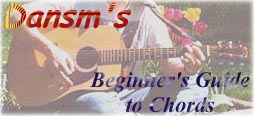
What Are Barre Chords?
Barre chords are an integral part of playing guitar. Probably 80% of all
chords are barre chords in various forms. A barre chord is formed
when you use your index finger to fret all the strings at one fret,
then add other fingers to form a chord. This use of the index finger
is called a "barre." Once you have barred the strings,
that fret, in effect, becomes the "nut," and any chord you build on top of
the barre regards that fret as the nut. Take a look at an example:

As you can see, the barred second fret in the right image simply
has an E chord built onto it, forming an F# chord.
In other words, an F# chord is simply an E chord with the nut at the second fret.
These chords are called E-derived barre chords because they are
formed similarly to E chords. There are also A-derived barre chords,
which are formed similarly to A chords. Both of these are covered in
my guide to barre chords. I hope this helps!
If you have any questions, feel free to e-mail me.
Back to Dansm's Guide to Barre Chords
Back to Dansm's Beginner's Guide to Chords
You are visitor number
 since 12-20-97
since 12-20-97
© 1997 Daniel E. Smith. Last updated 12-20-97


